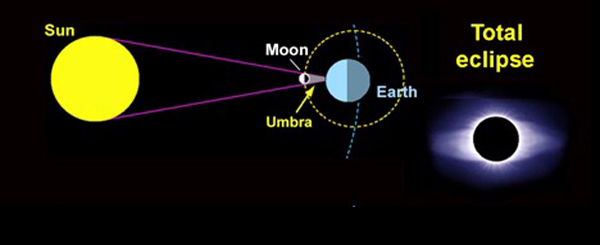On Aug. 21, 2017, a total solar eclipse will pass over the United States. The path of totality is located within one day's drive of Terre Haute and Indiana State University. In Terre Haute, 91% of the sun will be covered at maximum. "Baily’s beads" and the "diamond ring" effect will not be visible from Terre Haute.
Let's hope for clear skies. Remember that while Terre Haute, IN, is in Eastern time, Illinois and parts of Kentucky are in Central time. So make sure you know the right time for your area!
Read below to learn more.

 |
 |
Do NOT look at the sun without proper protection. You can damage your eyes.
(Ordinary sunglasses are not proper protection.)
An eclipse is a situation amongst three astronomical objects in which one moves between the other two creating a shadow, effectively blocking the view of the first astronomical object from the third astronomical object. A solar eclipse is when the moon moves between the Earth and the sun, totally blocking the view of the sun from those on Earth who are within the moon's shadow. A lunar eclipse is when the Earth is between the moon and the sun, blocking the view of the sun from the moon (if you happened to be on the moon).
Solar eclipses happen periodically. However, each individual solar eclipse impacts only a relatively small portion of the Earth. They also rarely occur nearby to where YOU are so that you can easily witness it for yourself.
You may find out what is known about eclipses within the information sources such as books, journal articles, newspapers, websites, and other forms of communication. An eclipse is also known as an occultation. If you search for information, try searching that word, too.
Below are some links to information about the 2017 total solar eclipse.
On April 8, 2024, a total solar eclipse will pass over the United States. The path of totality will include Terre Haute and Indiana State University.
 Total eclipse of the sun in 1900. Letter from the Acting Secretary of the Treasury, transmitting, for the consideration of Congress, a copy of a communication from the Secretary of the Navy, submitting an estimate of appropriation for observations of the
by
Total eclipse of the sun in 1900. Letter from the Acting Secretary of the Treasury, transmitting, for the consideration of Congress, a copy of a communication from the Secretary of the Navy, submitting an estimate of appropriation for observations of the
by
 Ancient Astronomical Observations and the Accelerations of the Earth and Moon
by
Ancient Astronomical Observations and the Accelerations of the Earth and Moon
by
 Eclipses of the sun
by
Eclipses of the sun
by
(1:10:14)
Harvard professors provide a quite lengthy but interesting and thorough explanation of eclipses and man's history of observing eclipes.
On Aug. 21, 2017, a total solar eclipse will pass over the United States. The path of totality is located within one day's drive of Terre Haute and Indiana State University.
Let's hope for clear skies. Remember that while Terre Haute, IN, is in Eastern time, Illinois and parts of Kentucky are in Central time. So make sure you know the right time for your area!
Playlists below include clips from the ISU video databases which explain or are related to eclipses. Some are about the science and some include portrayals of eclipses from dramatic film.
You, too, can create playlists of films or film clips on topics which interest you. Create a personal account in order to create playlists.
MEDLINE Subject Headings (MeSH) that can be used to search for eye damage from looking at an eclipse include:
Radiation Injuries/
Retina/radiation effects
Sunlight/adverse effects
Ultraviolet Rays/adverse effects
Radiation Injuries/
Eye Burns/
Fovea Centralis/*radiation effects
Retina/*injuries
Macula Lutea/*radiation effects
Keyword searches may include
solar maculopathy
solar retinopathy